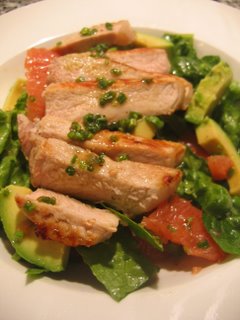 For Christmas last year my sister, Jo, bought me the Australian Gourmet Traveller ‘Modern Salads’ cookbook. It was a perfect gift, providing endless ideas for one of my favourite meals: salad.
For Christmas last year my sister, Jo, bought me the Australian Gourmet Traveller ‘Modern Salads’ cookbook. It was a perfect gift, providing endless ideas for one of my favourite meals: salad.I particularly love salads that include meats or fish, like tuna nicoise and yum nua (Thai beef salad).
One of the recipes I discovered in this book was a salad for pork with ruby grapefruit and avocado, which included an easy but interesting chive dressing.
Grapefruit is one of those things that I have tried again and again over the years. I keep on keeping on in the hope that one day my tastebuds will miraculously accept the flavour.
Gorgonzola, red wine, oysters, caviar and eel have all made it onto my menu through sheer determination. Capsicum, brussel sprouts, couscous, pumpkin and grapefruit are still out in the cold. In the wise words of a Kings Cross karaoke bar menu “basically it is not to be”.
Caramelised, grilled, sprinkled with sugar, frozen, in cocktails – all to no avail – but through this recipe I think I’ve found a way to make grapefruit palatable and potentially trick my tastebuds into a lifelong friendship.
But grapefruit it not actually my ingredient of focus for this Weekend Herb Blogging, hosted by Genie from The Inadvertent Gardener. Today it’s all about chives.
Let it be said that I love chives. They taste like herbs and onions rolled into one. Full of punch but verdant and healthy.
After the recipe, check out some of the interesting information I uncovered on chives through the internet.
 Pork, Ruby Grapefruit & Avocado Salad w Chive Vinaigrette
Pork, Ruby Grapefruit & Avocado Salad w Chive VinaigretteBased on a recipe from Australian Gourmet Traveller ‘Modern Salads’. Serves 4 as a light meal.
Ingredients:
4 pork cutlets
2 ruby grapefruit, peeled
2 baby cos lettuce
2 avocadoes
Chive Vinaigrette
1 teaspoons Dijon mustard
2 teaspoons sherry vinegar
1 tablespoon reserved ruby grapefruit juice
1/3 cup olive oil
¼ cup finely chopped chives (approx. 1 bunch)
Method:
1. Separate and cut baby cos leaves into 1cm thick slices. Wash and drain.
2. Segment grapefruit over a bowl to catch juices (find the white veins between each segment and cut on either side to separate crescent shaped slices).
3. Cut each avocado in half and remove the seeds. Take one half and slide a spoon between the flesh and the skin to remove the flesh. Slice into rounds and then cut in half again.
4. For chive vinaigrette, combine Dijon, vinegar and grapefruit juice in a bowl then gradually whisk in olive oil until emulsified. Season to taste and stir in chives just before serving.
5. Fry pork cutlets until cooked through. Remove from heat and allow to rest for 2 minutes. Slice into strips.
6. Combine baby cos, grapefruit segments, pork and dressing. Add avocado, stir gently and then serve.
Variation: Gourmet Traveller’s original recipe uses crumbed pork (schnitzel).
 Chives (Allium schoenoprasum) are bulb-forming herbaceous perennials that grow in clumps. Their leaves are firm, straight and hollow while the flowers are star-shaped globe clusters and range from deep purple to pink. I never imagined just how beautiful these flowers can be! Photo of chive flower from Wikipedia.
Chives (Allium schoenoprasum) are bulb-forming herbaceous perennials that grow in clumps. Their leaves are firm, straight and hollow while the flowers are star-shaped globe clusters and range from deep purple to pink. I never imagined just how beautiful these flowers can be! Photo of chive flower from Wikipedia. Chives belong to the same family as onions, leeks, and garlic (Alliaceae) and are the only species of Allium native to both the New and the Old World – which means they must be pretty old.
Chives belong to the same family as onions, leeks, and garlic (Alliaceae) and are the only species of Allium native to both the New and the Old World – which means they must be pretty old.The name chive comes from a French word “cive” which in turn derived from the Latin “cepa” meaning onion. Since chives grow in big clumps, they’re mostly referred to in plural form.
The species name for chives, schoenoprasum, comes from the Greek words skhoinos (sedge) and prason (onion).
Records show chives have been cultivated in Europe since the Middle Ages and by the sixteenth century they were common plants in herb gardens throughout Europe
Chives are gastronomically used all over the world. In Sweden they are particularly loved and in French cuisine they are considered one of the “fine herbs” along with tarragon, chervil and parsley. Chives are commonly paired with fish, eggs, potatoes, butter, cream and soups.
Chives have limited use as a medicinal herb because it has many of the same properties as garlic, only in much milder quantities. At the same time, negative reactions to chives are rarely encountered, although overeating can cause indigestion (but what doesn’t when you eat too much).
 Due to sulphuric properties, chives have insect-repelling properties. The juice of the leaves can also be used for fighting fungal infections, mildew and scab. Although it is an insect repellent, its flowers are very attractive to bees and are used in gardens where many plants need pollination. Chive sketch (above) comes from Wikipedia.
Due to sulphuric properties, chives have insect-repelling properties. The juice of the leaves can also be used for fighting fungal infections, mildew and scab. Although it is an insect repellent, its flowers are very attractive to bees and are used in gardens where many plants need pollination. Chive sketch (above) comes from Wikipedia.Chives thrive in well drained, slightly acidic soil that’s rich in organic matter and moisture. They require full sun and can be grown from seeds in early spring or by cutting clumps from the outer edges of an established patch and transplanting.
In winter, chives die back and new leaves appear in early spring. The flowers bloom for two months around midsummer and need to be removed if you want further production of the green leaves for eating. Apparently the flowers are popular used in dried ornamental bouquets.
When harvesting chives, snip them with scissors 5cm (2in) above the ground. It will take a while for them to grow back so make sure you don’t cut away the whole clump at once.
All leaves should be cut fairly regularly to produce further growth and remove tough leaves. It’s interesting to know that any new leaf growth will be quite tender.
So have a look at the other Weekend Herb Blogging taking place this weekend at Genie's recap.
 On another note, today is the seventh birthday of my Spiderman-loving nephew Matthew. He's a sweet boy with the most charming smile that would melt any heart. He's great at sharing his candy as well as handing out headbutts. I love that little arachnophile.
On another note, today is the seventh birthday of my Spiderman-loving nephew Matthew. He's a sweet boy with the most charming smile that would melt any heart. He's great at sharing his candy as well as handing out headbutts. I love that little arachnophile.Happy birthday!
References
http://en.wikipedia.org/wiki/Chives
http://www.gardenguides.com/herbs/chives.htm
http://www.ces.ncsu.edu/depts/hort/hil/hil-124.html


This sounds very yummy. I like all the ingredients so I'm guessing it's a winner for me. Great photo of the chive flower and fun seeing your nephew.
ReplyDeleteWell now I will definitely need to add chives to the list of things that I want to grow next spring. Plus that recipe sounds really interesting so I'm going to give it a try.
ReplyDeleteThat looks so good!
ReplyDelete